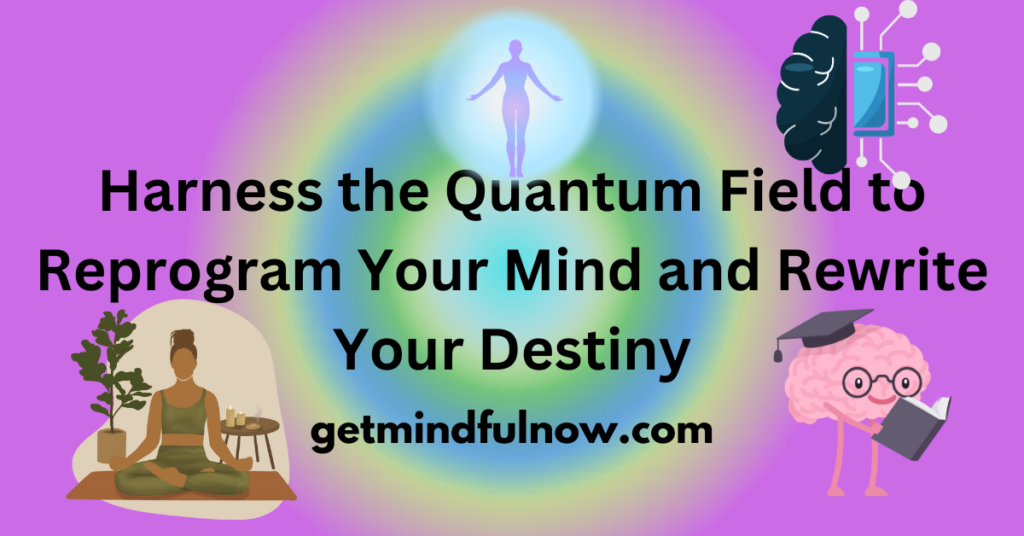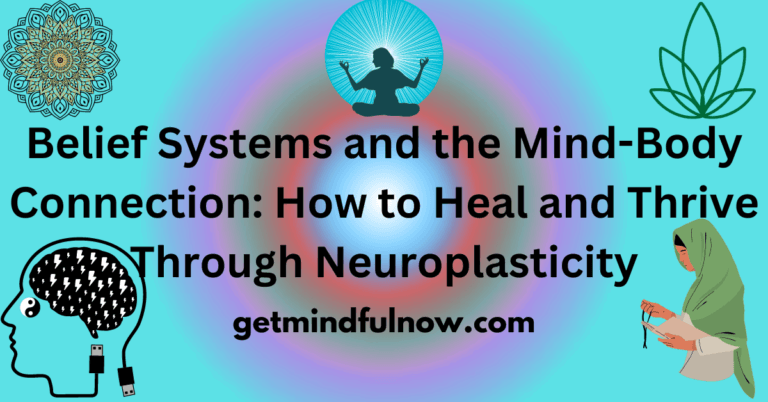Our beliefs shape our reality. Whether we realize it or not, the systems of belief that we adopt in our lives profoundly affect our health, well-being, and personal growth. But how deep does this influence go? Scientific breakthroughs in neuroplasticity and epigenetics have revealed that our beliefs not only shape our thoughts but also impact our physical bodies on a cellular level. In short, what you believe may have the power to heal you—or hold you back.
Modern science shows that belief is not just a psychological construct but a biological force that can rewire the brain, alter gene expression, and influence healing. In this article, we explore the profound impact of belief systems on the mind-body connection, supported by cutting-edge research, real-life case studies, and actionable tips you can use to harness the power of your own beliefs.
The Science Behind Belief and Its Impact on the Mind-Body Connection
Recent scientific discoveries have shown that belief has a profound impact on both the brain and the body. This isn’t just a mystical idea—it’s backed by cutting-edge research in neuroscience and epigenetics.
Neuroplasticity: How Beliefs Rewire Your Brain
Neuroplasticity refers to the brain’s ability to change its structure and function throughout life. This discovery was groundbreaking because it showed that we are not stuck with the brains we were born with—our experiences, thoughts, and beliefs can reshape the neural pathways that dictate how we think and feel.
For instance, if you consistently believe that you are capable of healing or succeeding, your brain strengthens the neural networks that support these thoughts. Conversely, limiting beliefs can form strong negative patterns in the brain that make failure or illness more likely. Studies on meditation and mindfulness, such as those conducted at Harvard Medical School, have demonstrated that regular mental practices can lead to physical changes in the brain, including increased grey matter density in areas responsible for memory, empathy, and stress management.
Real-Life Example: In a landmark study, patients who suffered from chronic pain were taught to meditate and focus on positive belief systems about their health. Over time, MRI scans showed changes in the brain areas associated with pain, and many patients reported significantly reduced symptoms—even though their physical conditions remained the same. This is a clear example of how belief and focused thought can rewire the brain to create better health outcomes.
Epigenetics: How Beliefs Influence Gene Expression
Epigenetics is the study of how our environment, including thoughts and beliefs, can influence the way our genes are expressed. This field has uncovered a powerful truth: we are not solely defined by our genetic code. The genes we inherit can be turned “on” or “off” based on environmental factors—including our beliefs.
For example, research has shown that chronic stress and negative beliefs can lead to the activation of genes related to inflammation and disease, while positive thoughts and belief in healing can promote the expression of genes linked to health and longevity. This means that by changing your belief system, you could be influencing your genetic blueprint in ways that improve your health.
Real-Life Example: In a study published in Psychoneuroendocrinology, cancer patients who participated in mindfulness-based stress reduction programs showed changes in the expression of genes related to immune function and inflammation. These patients believed in the power of their minds to help their bodies heal, and the results were evident on a genetic level.
How Your Belief System Shapes Your Reality
Your belief system is like a filter through which you interpret the world around you. Every experience, challenge, and opportunity is processed through the lens of your core beliefs. If you believe that life is full of potential, you are more likely to spot opportunities for growth and success. On the other hand, if you believe that you are stuck, your brain will highlight the obstacles that confirm this belief.
Personal Insight: My Journey of Rewriting a Core Belief
Growing up, I experienced a very traumatic childhood, which ingrained in me some deeply negative beliefs about myself. These beliefs weren’t just fleeting thoughts; they were strong and persistent, shaping how I saw the world and my place in it. For the longest time, I carried the belief that I was not worthy of love, abundance, or respect. No matter what I did or how hard I tried to change my life, this belief always haunted me, reminding me how miserable I was and reinforcing the idea that I was a victim.
It took years of inner work—and many failures—before I even began to shift this belief. It wasn’t easy, and at times, it felt like I was my own worst enemy, unknowingly sabotaging myself. But eventually, I came to a life-altering realization: these beliefs were not even mine. They were projections of someone else’s insecurities and self-image, assigned to me in my most vulnerable years. And yet, I had accepted them as truth.

Once I understood this, the real work began. I dove into intense meditations, using techniques to enter slow brainwave states, where I could access the subconscious mind more deeply. Through these meditations, I learned how to release those negative, destructive beliefs to a higher power and reprogram my mind with healthier, empowering ones. It wasn’t an overnight process, but slowly, those old beliefs lost their grip on me. In their place, I began to nurture new beliefs—ones rooted in love, abundance, and self-respect.
It’s a journey that continues, but this process has shown me firsthand just how powerful belief systems are. They are the compass that directs our lives, whether we realize it or not. And the beautiful thing is, they can be rewritten.
Perception Filters: Interpreting the World Through Beliefs
Our brains are wired to confirm what we already believe. This phenomenon, known as “confirmation bias,” ensures that we consistently find evidence to support our beliefs—whether they are empowering or limiting. For instance, if you believe that you are not good enough, your brain will constantly seek out situations and experiences that reinforce this idea, creating a self-fulfilling prophecy.
Breaking free from limiting beliefs involves becoming aware of these mental filters and consciously choosing new, empowering beliefs that align with the life you want to create.
Actionable Tip:
Start by identifying one limiting belief you hold. For example, if you believe that you’re not good at public speaking, write it down. Then, challenge it by recalling times when you successfully spoke in public. Replace the limiting belief with a new one: “I am capable of speaking confidently in front of others.” Repeat this new belief daily and visualize yourself thriving in those situations.
How Belief Transforms Your Health: The Placebo Effect
The placebo effect is one of the most compelling examples of how belief can influence the body. It illustrates how our expectations can shape physical outcomes, even when no active medical treatment is involved. People have experienced remarkable health improvements simply because they believed they were receiving healing.
What Is the Placebo Effect?
In simple terms, the placebo effect occurs when a person experiences real, measurable health improvements after receiving a treatment that has no therapeutic value—such as a sugar pill or a saline injection. The fascinating part is that their body responds as though they were receiving actual treatment. This effect isn’t just psychological; it’s a biological response driven by the mind’s belief in healing. The power of belief has been shown to lower blood pressure, reduce pain, and even alleviate symptoms of chronic illness.
How the Body Responds to Perceived Healing
When the mind believes healing is happening, it triggers a cascade of physical responses. The brain releases endorphins, dopamine, and other chemicals associated with healing and relaxation. These neurochemical changes promote improved immune function, reduced inflammation, and accelerated recovery. In fact, studies have shown that the placebo effect can account for up to 30% of a treatment’s effectiveness, depending on the individual’s expectations. The more someone believes in the possibility of healing, the more likely they are to experience significant physiological changes.
In a study published in The New England Journal of Medicine, patients with osteoarthritis of the knee who underwent “sham” surgery (where no actual procedure was performed) reported the same pain relief as those who received the real surgery. Their belief that they had received treatment was enough to spur real, measurable improvements in their condition.
How to Use the Placebo Effect to Your Advantage
If belief can heal, how can you harness this power consciously? Start by practicing visualization and affirmations. By visualizing yourself healthy and strong every day, you’re sending signals to your brain that promote positive changes in your body.
Actionable Tip:
Set aside 10 minutes a day for a visualization exercise. Close your eyes and imagine your body in a state of perfect health. Picture every cell in your body filled with vitality and energy. Feel the emotions of being healthy, joyful, and at peace. Over time, your brain will begin to align with these images, reinforcing a state of well-being.
Miracles: Tapping into the Extraordinary Power of Belief
What many people refer to as “miracles” are often cases of individuals overcoming immense challenges through the sheer power of belief. These transformations may seem extraordinary, but they’re well-documented and increasingly understood through the lens of neuroscience and psychology. When we align our thoughts, emotions, and beliefs, we can tap into a level of personal power that can create what some might call miracles.
If you’re intrigued by the power of the quantum field and how it can transform your life, don’t miss the opportunity to watch the new film “SOURCE: It Is Within You.” This groundbreaking movie dives deep into the principles of consciousness, energy, and personal transformation, aligning closely with the ideas we’ve explored here. Best of all, it’s available to watch for free online on September 28th. To claim your free ticket, simply visit sourcethefilm.org and enter your email. This is a unique chance to gain deeper insights into how the quantum field works and how you can harness it to create the life you desire. Don’t miss out!
Real-Life Accounts of Healing and Transformation
Throughout history, there are countless stories of people who have healed themselves of seemingly incurable diseases. These cases are not necessarily miracles in the supernatural sense, but rather examples of how powerful belief systems, combined with mental focus, can create real-world outcomes.
The Intersection of Faith and Neuroscience
The science behind belief-based healing is rooted in the brain’s capacity to adapt and change—neuroplasticity. The subconscious mind plays a powerful role in influencing our physical health. When we hold a strong belief, the brain activates neural pathways that support this reality, often leading to tangible improvements in the body. This is why practices such as meditation, visualization, and affirmations are so effective in promoting well-being; they align the conscious mind’s intention with the subconscious mind’s ability to bring about physical change.
The Science of Miraculous Recovery: A Deeper Dive
Miraculous recoveries are often labeled as unexplainable by traditional medicine, but advances in neuroscience and epigenetics suggest there’s more to the story. These recoveries may be the result of intentional belief systems that engage the body’s innate ability to heal. The mind, through its focus on positive outcomes and healing, can stimulate profound biological changes.
Spontaneous Remission and the Power of Intention
Spontaneous remission—where someone recovers from a life-threatening illness without medical intervention—is an area where belief plays a critical role. Scientists studying these cases have found that many of these individuals held an unwavering belief that they would heal, despite grim diagnoses. This belief activates the body’s natural healing mechanisms, leading to dramatic and often “miraculous” recoveries.

The Role of Conscious and Subconscious Mind in Healing
The conscious mind sets an intention, but it’s the subconscious mind that carries out the work. The subconscious is constantly processing information, and it has the power to alter the body’s physiology without conscious effort. By reprogramming the subconscious through consistent beliefs, positive affirmations, and focused intention, individuals can create significant changes in their health and well-being.
Practical Techniques to Master Your Mind and Body
Mastering the mind-body connection isn’t a mysterious process—it’s something anyone can do with the right tools and a little practice. Below are some practical, step-by-step techniques you can use to start rewiring your brain and transforming your belief system today.
Meditation for Mind-Body Alignment
Meditation is a foundational practice for aligning your mind and body. It allows you to quiet the chatter of the conscious mind and connect with the deeper subconscious. Through regular meditation, you can rewire your brain, reduce stress, and cultivate a sense of inner peace. This state of calm is essential for letting go of limiting beliefs and adopting new, empowering ones.
Meditation also strengthens the mind-body connection by focusing your attention inward. When you meditate, you can visualize the outcomes you desire, whether it’s healing a part of your body, overcoming a mental hurdle, or achieving a goal. The more vivid your visualization, the more powerfully it imprints on your subconscious mind.
Daily Meditation for Rewiring the Brain
Meditation is a powerful way to calm the mind, reduce stress, and rewire your brain. By focusing inward, you can quiet the negative chatter of limiting beliefs and create space for new, empowering thoughts to take root.
Step-by-Step Meditation Practice:
- Find a quiet place where you won’t be disturbed.
- Sit or lie down in a comfortable position.
- Close your eyes and take a few deep breaths, relaxing your body.
- Focus on your breath or a positive affirmation, like “I am healthy and strong.”
- If your mind wanders, gently bring it back to your breath or affirmation.
- Practice for 10-20 minutes daily.
Over time, this practice will help you cultivate more positive beliefs and a healthier mind-body connection.
Visualization: Creating the Future You Want
Visualization is another tool to strengthen your belief system. By imagining the outcomes you want with vivid detail, you send signals to your brain that these outcomes are possible and even inevitable.
Actionable Tip:
Before bed, spend five minutes visualizing yourself achieving a specific goal—whether it’s better health, success in your career, or personal growth. Feel the emotions that come with achieving that goal, and allow yourself to fully experience it as if it has already happened.
In addition to meditation, establishing daily rituals that reinforce your desired beliefs is key to mastering your mind and body. This could involve writing down positive affirmations, journaling about the life you want to create, or simply taking a few moments each day to visualize your ideal future. The more consistently you engage in these rituals, the stronger your new belief system will become.
Cultivating Mindfulness for Greater Control Over Your Body
Mindfulness—the practice of staying present in the moment—is another powerful way to master your mind and body. When you are mindful, you become more aware of your thoughts, emotions, and physical sensations. This heightened awareness allows you to catch limiting beliefs as they arise and consciously choose more empowering ones. Mindfulness also reduces stress, which has a direct impact on your physical health by lowering cortisol levels and boosting your immune system.
The key to mindfulness is focusing on the present moment. One simple technique is to take several deep breaths, paying attention to the sensation of air entering and leaving your body. By focusing on your breath, you anchor yourself in the present, which helps quiet racing thoughts and calms the nervous system. Over time, regular mindfulness practice leads to a more relaxed, responsive body and a clearer, more focused mind.
Breathing Techniques for Centering Your Mind
Breathing is a direct link between your mind and body. When you learn to control your breath, you can influence your state of mind and, in turn, your physical state. Techniques like diaphragmatic breathing or alternate nostril breathing can calm the nervous system and increase oxygen flow to the brain. These simple practices not only reduce stress but also enhance focus and clarity, helping you maintain a strong connection between your mind and body.
The Role of Emotions in Manifesting Change
Your emotions are the fuel for your beliefs. While thoughts set the course, it’s your emotions that provide the energy needed to manifest change. When you align your beliefs with elevated emotions—such as love, gratitude, and joy—you create a powerful signal that influences both your brain and body. This emotional alignment is key to transforming your reality.
The Impact of Elevated Emotions on Your Physiology
Elevated emotions trigger positive biochemical changes in your body. When you feel love, joy, or gratitude, your brain releases neurotransmitters like dopamine and serotonin, which promote healing, enhance mood, and improve overall well-being. These emotions also strengthen your immune system and lower inflammation, which is crucial for maintaining good health.
Using Positive Emotions to Create Your Future
By intentionally cultivating positive emotions, you can accelerate the process of belief-driven transformation. Visualization is one technique to enhance this: as you imagine the future you desire, feel the emotions associated with achieving it. These feelings will amplify your intention and help create a physiological state that aligns with your desired outcomes.
Belief directly influences the brain’s chemistry. When you think positive, empowering thoughts, your brain produces chemicals that promote well-being and healing. On the flip side, limiting beliefs can trigger stress responses that negatively impact your health. Understanding this connection allows you to consciously shape your thoughts to create the brain chemistry that supports your desired reality.
Dopamine, Serotonin, and Their Relationship to Your Thoughts
Dopamine and serotonin are neurotransmitters that play a crucial role in how we feel. Dopamine is associated with motivation and reward, while serotonin is linked to mood regulation and a sense of well-being. When you hold positive beliefs and engage in uplifting activities, these chemicals are released in higher quantities, reinforcing a cycle of positive health and mental clarity.
Rewiring Your Brain for Joy and Healing
By consistently practicing positive beliefs, visualization, and affirmations, you can literally rewire your brain. Neuroplasticity, the brain’s ability to change and adapt, allows us to form new neural pathways that support health, happiness, and success. The more you reinforce empowering beliefs, the stronger these pathways become, making it easier to maintain positive changes in the long term.
Mastering your mind and body is about aligning belief, intention, and action. When these three elements work together, you become the architect of your own reality. This mastery isn’t a one-time event but a continuous process of refining your beliefs, focusing your mind, and taking inspired action.
Aligning Belief, Intention, and Action for Transformation
The most successful transformations occur when your beliefs, intentions, and actions are in harmony. If you believe in your ability to heal or achieve a goal, set a clear intention to make it happen, and then take consistent action, the universe will align to support you. It’s not just about thinking positive thoughts—it’s about backing those thoughts with meaningful action.
How to Sustain Change in the Long-Term
Sustaining change requires a commitment to ongoing personal growth. Even when you achieve your desired results, it’s important to continue nurturing your belief system. Regular meditation, visualization, and self-reflection will help you stay aligned with your goals and maintain the mastery of your mind and body.
Conclusion: How to Become Your Own Healer
Ultimately, you have the power to become your own healer, your own miracle worker. You are the placebo in your life—the one who can create real change simply by believing it’s possible. From healing your body to achieving your personal and professional goals, the beliefs you hold create the foundation for the life you experience. By understanding the science behind neuroplasticity and epigenetics, and by applying simple daily practices like meditation and visualization, you can take control of your belief system and transform your health and life.
Take a moment to reflect on your own belief systems. What limiting beliefs might be holding you back? What new, empowering beliefs could you adopt today? Share your thoughts in the comments below and begin your journey towards mastering your mind and body!
FAQs
1. How does belief directly influence physical health?
Belief influences physical health by triggering changes in brain chemistry. Positive beliefs release neurotransmitters like dopamine and serotonin, which promote healing and reduce stress. On the other hand, limiting beliefs can activate the body’s stress response, negatively impacting health over time.
2. Can someone really heal themselves through belief alone?
Yes, research has shown that belief can trigger physiological responses that promote healing, as seen in cases of the placebo effect. While medical intervention is often necessary, belief plays a critical role in the body’s ability to heal.
3. What are the best techniques to shift your belief system?
The best techniques include meditation, visualization, affirmations, and mindfulness. These practices help reprogram your subconscious mind, making it easier to replace limiting beliefs with empowering ones.
4. How do emotions impact our beliefs?
Emotions fuel beliefs. Positive emotions like joy and gratitude reinforce empowering beliefs, while negative emotions like fear and doubt strengthen limiting ones. Cultivating positive emotions is key to transforming your belief system.
5. How does meditation help rewire the brain?
Meditation quiets the conscious mind and allows access to the subconscious, where deep belief systems reside. Regular meditation can rewire the brain by forming new neural pathways that support positive thoughts and behaviors.
6. What are some examples of the placebo effect in action?
Examples of the placebo effect include patients experiencing pain relief from sugar pills, improvement in depression symptoms from inactive medications, and even recovery from chronic illnesses through sham surgeries where no actual treatment was performed.









I’m blown away by the connection between belief systems and physical health! It’s amazing to think that by changing our thoughts, we can actually impact our bodies. This post has given me so much hope and motivation to work on shifting my mindset for healing. Thank you for making neuroplasticity feel so accessible and powerful!
This article was exactly what I needed! The way you explained how our belief systems impact our physical health was eye-opening. Learning that we can rewire our minds through neuroplasticity to heal and thrive makes me feel so much more in control of my own well-being. I’m excited to start putting this into practice—thank you for such an empowering read!